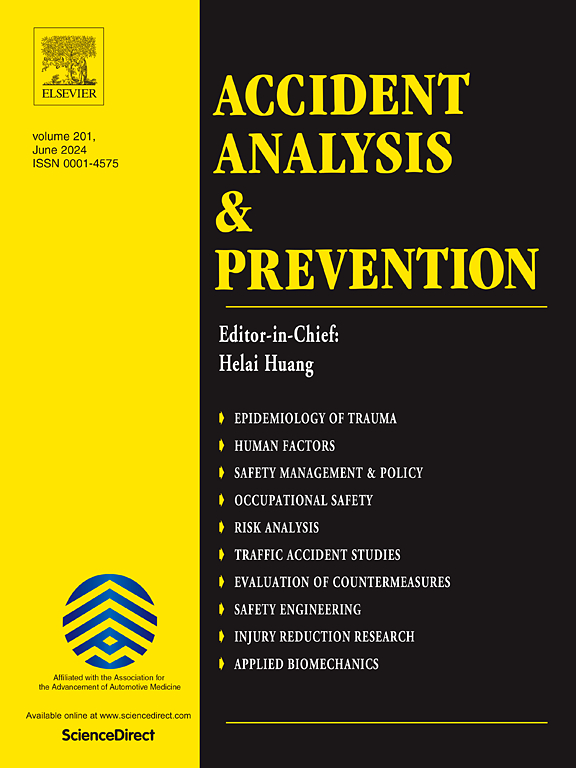黄色校车碰撞结果:随机参数及相关随机参数logit模型
IF 6.2
1区 工程技术
Q1 ERGONOMICS
引用次数: 0
摘要
尽管有严格的安全标准,但美国校车每年仍发生约2.6万起撞车事故,造成约10人死亡,尽管车辆安全性有所提高,但死亡率始终保持不变。这类事故往往会产生重大影响,尤其是对涉及的年轻乘客而言。本研究采用了一种新颖的方法,通过具有均值异质性(RPLHM)和相关RPLHM (CRPLHM)的随机参数Logit模型,分析了2017年至2022年德克萨斯州撞车记录信息系统(CRIS)的数据。该方法允许对数据中未观察到的异质性和特定方差进行详细检查,从而增强对影响碰撞严重性的复杂动力学的理解。分析显示,在州际高速公路上发生撞车事故的可能性通常较低。此外,年龄等人口统计属性对碰撞结果有显著影响,中年司机(25-54岁)的受伤程度通常较轻。此外,驾驶员注意力不集中与无伤害碰撞结果的发生率增加有关。虽然日光与轻度和可能的伤害事故有关,但晴朗的天气与更高的无伤害事故有关。可转移性测试揭示了2017-2022年黄色校车碰撞严重程度模式的时间不稳定性。十字路口、日光和驾驶员特征等关键变量随着时间的推移显示出不同的影响。虽然在随后的几年里,上午和下午的撞车事故越来越多地降低了致命和严重伤害的可能性,但道路分隔和晴朗天气等因素对无伤害和中度伤害结果的影响却存在更大的差异。这些发现强调了年份建模的重要性,并支持数据驱动的政策制定,以改善校车安全。本文章由计算机程序翻译,如有差异,请以英文原文为准。
Crash outcomes of yellow school buses: Random parameter and correlated random parameter logit models with heterogeneity in means
Despite rigorous safety standards, school buses in the United States still experience around 26,000 crashes annually, resulting in approximately 10 fatalities, with a fatality rate persistently static despite advances in vehicle safety. Such crashes often have significant implications, particularly for the young passengers involved. This study utilized a novel approach by analyzing Texas Crash Records Information System (CRIS) data from 2017 to 2022 through a Random Parameter Logit Model with Heterogeneity in Means (RPLHM) and Correlated RPLHM (CRPLHM). This method allows for a detailed examination of unobserved heterogeneity and specific variances within the data, enhancing the understanding of the complex dynamics influencing crash severity. The analysis revealed that crashes on state highways typically presented a lower likelihood of fatal and severe crash outcomes. Additionally, demographic attributes such as age significantly impacted crash outcomes, with middle-aged drivers (25–54) often experiencing less severe injuries. Additionally, driver inattention was associated with an increased occurrence of no-injury crash outcomes. While daylight is associated with less moderate and possible injury crashes, clear weather was associated with higher no-injury crashes. The transferability tests revealed temporal instability in yellow school bus crash severity patterns across 2017–2022. Key variables such as intersections, daylight, and driver characteristics demonstrated varying effects over time. While morning and afternoon crashes increasingly reduced the likelihood of fatal and severe injuries in later years, factors like divided roadways and clear weather saw greater variability in their impact on no-injury and moderate injury outcomes. These findings highlight the importance of year-specific modeling and support data-driven policymaking to improve school bus safety.
求助全文
通过发布文献求助,成功后即可免费获取论文全文。
去求助
来源期刊

Accident; analysis and prevention
Multiple-
CiteScore
11.90
自引率
16.90%
发文量
264
审稿时长
48 days
期刊介绍:
Accident Analysis & Prevention provides wide coverage of the general areas relating to accidental injury and damage, including the pre-injury and immediate post-injury phases. Published papers deal with medical, legal, economic, educational, behavioral, theoretical or empirical aspects of transportation accidents, as well as with accidents at other sites. Selected topics within the scope of the Journal may include: studies of human, environmental and vehicular factors influencing the occurrence, type and severity of accidents and injury; the design, implementation and evaluation of countermeasures; biomechanics of impact and human tolerance limits to injury; modelling and statistical analysis of accident data; policy, planning and decision-making in safety.
 求助内容:
求助内容: 应助结果提醒方式:
应助结果提醒方式:


